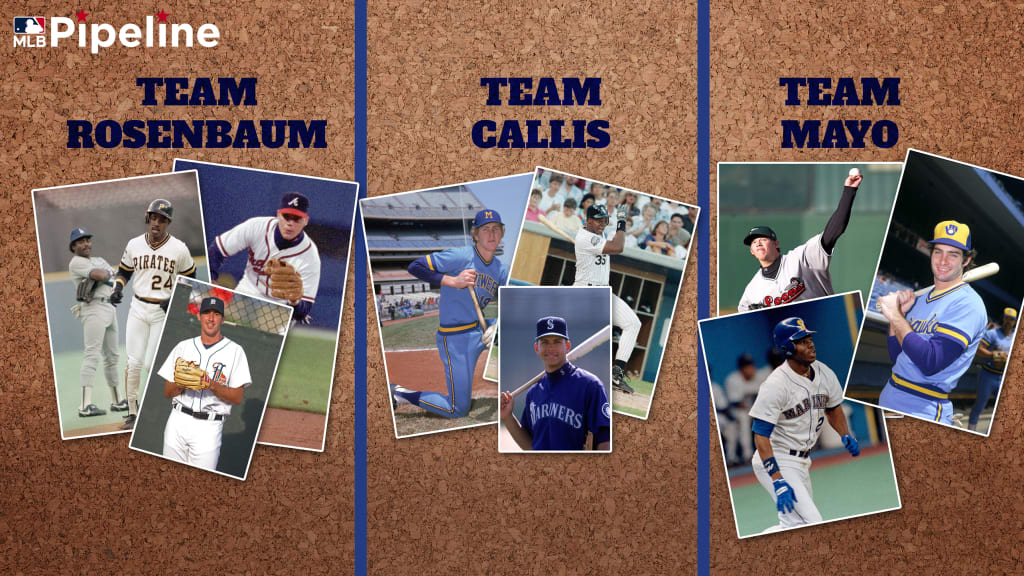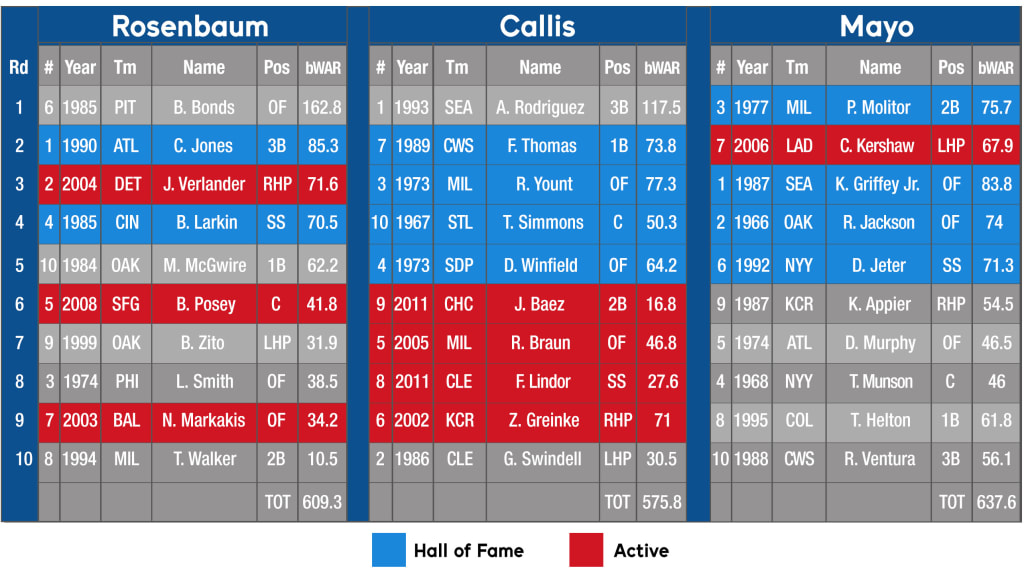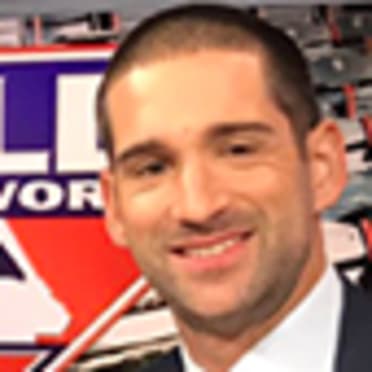
It’s usually said that you can’t tell how successful a Draft is until at least five years after it takes place. The reason is fairly obvious: You have to wait to see which draftees make it to the big leagues and what kind of impact they have.
But what if you could draft your own lineup, with hindsight in your corner? That’s what the three of us tried to do with this exercise. The ground rules were fairly simple:
- Each of us needed to fill out a lineup -- one player at each position, a left-handed pitcher and a right-handed pitcher -- for a total of 10 draft picks.
- All selections had to come from the top 10 picks of the June Draft, dating to its inception in 1965.
- Once you took a player from a certain slot, you couldn’t use that number pick again. Taking an example from below, once Mike Rosenbaum took Barry Bonds No. 1 overall, he couldn’t take another No. 6 overall pick to fill another of his roster spots.
There were different ways to go about doing this, from looking at position and Draft slot scarcity, to contemplating future performance of active players rather than focusing solely on past/present value.

Round 1
1. Mike: Barry Bonds, OF (No. 6, 1985, Pirates)
Easily the best player available and a slam-dunk 1-1 pick for me, Bonds compiled 162.8 WAR during a 22-year career that featured seven MVP Awards, including four straight from 2001-04 (43.4 WAR in that span). Plus, as a No. 6 Draft pick, you just can’t beat that type of value in this format. For what it’s worth, Jim proposed several reasonable trades in an attempt to get the No. 1 pick, but I just couldn’t give the guy the satisfaction.
2. Jim: Alex Rodriguez, 3B/SS (No. 1, 1993, Mariners)
I unsuccessfully tried to trade for the No. 1 pick and would have given up a lot to do so, because Bonds is clearly the best player, with his career magnified by the fact that he lasted six picks in 1985. That said, A-Rod was an easy second choice for me, because he clearly had the second-best career of all the top-10 picks and has a lot of positional value.
3. Jonathan: Paul Molitor, 2B (No. 3, 1977, Brewers)
I decided to go position scarcity with my first selection. There aren’t many good options at second base among top 10 picks, with Molitor so much better than any other choice. He spent more time at DH than anywhere else, but the Hall of Famer played enough games at second to qualify (one-third of career games played in the field being our threshold).
Round 2
4. Jonathan: Clayton Kershaw, LHP (No. 7, 2006, Dodgers)
Scarcity figured into this decision, too. Kershaw’s WAR to date (67.9) is almost double the next lefties on the list (David Price, Jon Matlack at 39.4), clearly making Kershaw the best southpaw taken in the top 10 ever.
5. Jim: Frank Thomas, 1B (No. 7, 1989, White Sox)
Though Thomas going seventh overall was considered a reach at the time in 1989, he quickly became one of the more devastating right-handed hitters ever. Jonathan made a pair of great value picks. I was hoping for Kershaw and liked Thomas a lot more than the other options with the No. 8 picks.
6. Mike: Chipper Jones, 3B (No. 1, 1990, Braves)
With A-Rod and Molitor already off the board, Jones and his career 85.3 WAR represented a roughly 30-WAR difference over the next best option (Robin Ventura, 56.1) at the hot corner. While I’m not thrilled about having to burn my No. 1 slot with my second overall pick, the positional value was too good to pass up.
Round 3
7. Mike: Justin Verlander, RHP (No. 2, 2004, Tigers)
Having already used my No. 6 slot on my first pick (Bonds), I shifted my focus to RHP, a category that has a sharp dropoff in talent after the first four spots. Verlander (71.6 WAR) sits atop that list, and it made sense to grab him now rather than attempt to land a higher-WAR player at a more populated position.
8. Jim: Robin Yount, OF/SS (No. 3, 1973, Brewers)
I really wanted Verlander but pivoted to Yount, so now two of my first three picks will be in the big leagues at 18. I have some good positional versatility working that hopefully will come in handy later, and I was concerned about the dropoff at the No. 3 slot if I didn’t get Yount.
9. Jonathan: Ken Griffey Jr., OF (No. 1, 1987, Mariners)
I decided to switch from position scarcity to Draft spot scarcity for these two picks. There’s a huge dropoff WAR-wise from Junior (83.8) to the next No. 1 overall pick, Joe Mauer (55.3). Griffey was also the next highest player still on the board, according to WAR. In hindsight, I realized that I could've waited to take Junior because Mike and Jim had already taken No. 1 overall picks. But I still think there was nothing wrong with taking the next highest-ranked player, according to WAR, still on the board.
Round 4
10. Jonathan: Reggie Jackson, OF (No. 2, 1966, Athletics)
Reggie is the top WAR accumulator (74) taken No. 2. With Verlander gone, there’s quite a dropoff to the next available player (Will Clark, 56.5). The difference between Jackson and Gary Sheffield (60.5), the next best outfield option, also figured into my calculations.
11. Jim: Ted Simmons, C (No. 10, 1967, Cardinals)
I’m quickly realizing you have to play defense more than offense here. We’re starting to get boxed into corners -- I should have taken Reggie over Yount, a mistake that is going to cost me about 45 accumulated and projected WAR -- and I think my path to assembling the best team I can now is taking the new Hall of Famer here. When I factor in round scarcity, he’s as valuable as any catcher in this draft.
12. Mike: Barry Larkin, SS (No. 4, 1985, Reds)
Needing a shortstop and staring at a 25-plus WAR dropoff after A-Rod, Yount, Jeter and Larkin, I used my fourth-round pick on Larkin (70.5 WAR). He surely would have been gone had I waited until my next turn, in which case I likely would have had to pick from one of Troy Tulowitzki (44.5), Jay Bell (37.2) or Francisco Lindor (27.6).
Round 5
13. Mike: Mark McGwire, 1B (No. 10, 1984, A’s)
Not only was Big Mac’s 62.2 WAR the second-best mark among first basemen (after Frank Thomas), but he also led all No. 10 overall picks in that department. That type of value was too good to pass up and hopefully will force Jonathan’s hand as he contemplates which lesser first baseman to take with his remaining picks. I’m playing for keeps.
TRADE: Jim trades his next two picks (Nos. 14 and 17) for Jonathan’s next two picks (Nos. 15 and 16)
14. Jonathan: Derek Jeter, SS (No. 6, 1992, Yankees)
This could be a trade that ends up benefiting both organizations. I coveted Jeter, as he was by far the next best shortstop, and while Jim had shortstops on his roster, their positional flexibility meant he could’ve taken the Yankees Hall of Famer. So I was happy to trade up to get him and let Jim take the next two guys.
15. Jim: Dave Winfield, OF (No. 4, 1973, Padres)
After Jonathan stung me with the Reggie pick, I began pairing up positions with Draft slots that I could interchange if needed. (Yes, I have a competition problem.) I didn’t want to get stuck drafting one half of a pair only to see Jonathan pick the other half before my next choice, so I proposed the trade we executed. He got Jeter, who fits nicely on his team and whom I could have taken, and I’m happy to snag Winfield. I can even use him out of the bullpen -- he was drafted as a RHP/OF and struck out 15 in the College World Series in his last-ever pitching appearance.
Round 6
16. Jim: Javier Baez, 2B/SS (No. 9, 2011, Cubs)
This choice may seem odd but it makes sense. The second-base crop is extremely thin, Baez already has the second-most WAR (16.8) and should more than triple that total by the time he’s done. And because we’re getting hemmed in at what positions or Draft slots we can select, three of my final four targets can’t be taken by Jonathan or Mike.
17. Jonathan: Kevin Appier, RHP (No. 9, 1987, Royals)
Did you know that no No. 9 pick in history has accrued more WAR than Appier’s 54.5? Neither did I before we started this draft. I had a choice between Appier and Dwight Gooden for RHP, but the dropoff between Appier and any other No. 9 selection put him over the top.
18. Mike: Buster Posey, C (No. 5, 2008, Giants)
Though I had been eyeing Posey at the turn with my two previous picks, a look a Jim and Jonathan’s rosters led me to believe that the three-time World Series champ would still be there for my sixth-round pick. Thurman Munson (46 WAR) was the only backstop ranked above Posey, but I had previously used my No. 4 slot on Larkin and his 70.5 WAR.
Round 7
19. Mike: Barry Zito, LHP (No. 9, 1999, A’s)
Mayo strategically sabotaged us when he took Kershaw (67.9 WAR), the top-ranked LHP on our draft board, with his second-round pick, as it left me and Jim with our pick from a slew of sub-40 WAR southpaws. With a No. 9 pick still in play for me, I opted to grab Zito -- my favorite of the A’s Big Three -- with my seventh-round pick.
20. Jim: Ryan Braun, OF (No. 5, 2005, Brewers)
It’s pretty much a dead heat between Braun, Dale Murphy and J.D. Drew among outfielders selected No. 5 overall, which is a must-have demographic for me at this point. My heart says Murphy but Braun will probably add a few more WAR in the next few years, so I’ll take him.
21. Jonathan: Dale Murphy, OF (No. 5, 1974, Braves)
Things are kind of locked in for me at this point and I needed one more outfielder. As Jim mentioned above, there were three outfielders all in the same ballpark. When Jim took Braun, Murphy was the pick for me.
Round 8
22. Jonathan: Thurman Munson, C (No. 4, 1968, Yankees)
I realized a while ago that both Jim and Mike had taken a No. 4 pick guy, so I could wait on this. Like Mike, I was also eyeing Posey, but I’m thrilled to get the catcher with third-highest WAR in Draft history here.
23. Jim: Francisco Lindor, SS (No. 8, 2011, Indians)
I now have players who were taken back-to-back in the 1973 and 2011 Drafts, though that reminds me again how I should have taken Reggie and waited a round on Yount. I’ll console myself with the fact that based on projected career WAR plus position and Draft slot, I thought Lindor was the third-most valuable player on the board behind Bonds and A-Rod.
24. Mike: Lonnie Smith, OF (No. 3, 1974, Phillies)
Needing to fill two-thirds of my outfield with three picks remaining, I had no choice but to maximize potential value and grab the highest-WAR outfielder still on the board in Smith (38.5).
Round 9
25. Mike: Nick Markakis, OF (No. 7, 2003, Orioles)
Yeah, so, um, apparently I neglected my outfield a bit. Anyway, I still managed to snag Markakis, a 34.2 WAR player (and counting) through 14 big league seasons, with my ninth-round pick. Overall, my three outfielders accounted for 235.5 of my team’s overall 609.3 WAR.
26. Jim: Zack Greinke, RHP (No. 6, 2002, Royals)
I know I did more prep for this draft than Mike and Jonathan -- it’s a sickness -- but I just now realized I forgot to account for the fact that Greinke’s career isn’t over. I was guaranteed to get him once Jonathan took Jeter, and just now am realizing he should have been the top RHP on my board (with his Draft slot putting him just ahead of Verlander).
27. Jonathan: Todd Helton, 1B (No. 8, 1995, Rockies)
I needed my two corner infielders and knew I could wait for the last two picks because both Jim and Mike had their first basemen and also used their picks at No. 8 and 10. This works out nicely for me because Helton has the third-highest WAR (61.8) of any first baseman taken in the top 10 picks.
Round 10
28. Jonathan: Robin Ventura, 3B (No. 10, 1988, White Sox)
Of those who qualify at the hot corner, Ventura has the fourth-highest WAR at 56.1 (and I also got No. 3 on that list as my 2B -- Paul Molitor). I also feel good about nabbing the player with the second-highest WAR among No. 10 picks, behind only Mark McGwire.
29. Jim: Greg Swindell, LHP (No. 2, 1986, Indians)
This is where I pay for my Reggie mistake, taking the player with the least relative value in this draft. Swindell had a decent career, but he pales in comparison to Verlander and Mr. October in the No. 2 slot. If I had it to do over, I take Reggie in the third round, still get Yount in the fourth round and pull off Posey at catcher/No. 5 and Madison Bumgarner at lefty/No. 10.
30. Mike: Todd Walker, 2B (No. 8, 1994, Twins)
Can’t win every round/position, right? Walker is a fine pick on paper given the dearth of second-base options, but I would have preferred not to use my 10th-round selection on a 10.5 WAR player. Also, I didn’t realize Jim was using projected career WAR for active players. I guess I wasn’t around when that vote passed in the Pipeline Senate.


